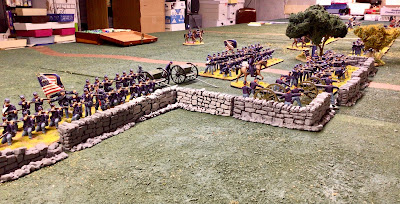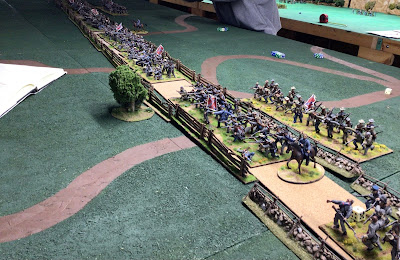 |
| Union troops defending "The Angle" atop Cemetery Ridge in the center of their line. This is Lt. Cushing's battery of 3-inch ordnance rifled cannon. |
On Presidents' Day our group travelled to the home of our gaming friend Keith Leidy to run a play test of my Pickett's Charge game for Little Wars and Historicon later this year. I hauled all of the soldiers and terrain bits to Keith's house several days ahead of the game so that everything would be ready to go once all of the players showed up on game day.
The purpose of the play test covered several aspects; (1) setting up the terrain and seeing how many troops could be used on the 6ft by 24ft tables that I will use for my convention games; and (2) playing the scenario and giving the rules a work out. As a result I was able to determine the optimal spacing of terrain on the table top, things such as where to position the Emmitsburg Road and Cemetery Ridge, and figure out the frontages of the Confederate brigades that will be involved in my game scenario. Along those lines, it is important to see how many turns of movement the Confederates need to reach the road and then to be in a position to directly engage the Union regiments. After all, we are asking the Confederate troops to cross 6 to 8 feet of table top distance before they hit the Emmitsburg Road, and as such we need the infantry movement to be of sufficient length so as to minimize the amount of time it will take them to cross that deadly open space.
 |
| Union forces atop Cemetery Ridge |
 |
| The Emmitsburg Road runs down the length of the middle table. |
 |
| The Confederates starting position on Seminary Ridge. The actual game will have an elevation for the ridge and game mats will decorate the length of the table top. |
We settled on infantry movement of 16-inches plus one D6 die and this seemed to work well.
We also worked on things such as the range of small arms and artillery. The game test indicated that the Confederates would take a moderate number of casualties from artillery fire until they reached the Emmitsburg Road, which acts a significant terrain obstacle for the advancing Confederates.
 |
| Confederates in the Emmitsburg Road. There will be road sections on the table in the convention games. |
For a brief moment I was concerned that the Confederates were not taking sufficient casualties, but once they got stuck climbing over the post and rail fences along the road, they were in range of small arms fire and this proved to be devastatingly effective. I think that by the time we stopped the game, the Confederates only had two regiments that stood any chance of reaching the copse of trees on Cemetery Ridge. The rest of their regiments were either all shot up or running away.
I think that we did a good job of achieving historical results, however, this does not make for a very good or playable war game in a convention setting. So we are going to tweak the effectiveness of musket/rifle fire to give the Confederates some chance of reaching the Union position on Cemetary Ridge.
 |
| The Angle defended by Webb's brigade. |
 |
| Union troops in th Copse of Trees at the center of the Union defense. |
Our first pass at small arms fire provided the firing unit with three D6 per stand of figures that the regiment has. So as the regiment loses figures and remove a stand, the fewer dice it will have to use to fire at the opponent. We agreed that that the small arms fire was too effective so in our next play test on March 5th we will reduce the number of dice to two D6 per stand. So now a fresh regiment will fire with ten D6 dice (5 stands x 2 D6 = 10 D6 dice) instead of 15 dice.
We are using ranges of Short, Medium and Long range for musketry and the firing unit will need to roll a 6 to hit at long range, a 5 or a 6 at medium range, and a 4, 5 or 6 at short range. A regiment gets to use a stand for purposes of determining the number of dice that it will roll. So for example, a 30 figure regiment has five stands of six figure, but has lost five figures from firing. That regiment will still get to use that fifth stand when it shoots, but once that sixth man goes down and the stand is removed, the regiment will only have four stands and thus throw 8 D6. The mechanics will be the same for the next game, but the number of dice thrown will be reduced.
Artillery fire rules worked well and we don't think that we have to make any significant changes. Each battery consists of two cannon, both having crews of 4 figures plus one reserve or mulligan figure that can be used to replace the first crew casualty. A cannon rolls one D6 for each crew manning the gun. Confederate artillery can fire at Cemetery Ridge up to the point where the Confederates cross over the Emmitsburg Road. After that the Rebs are deemed to be too close to the ridge to fire over the infantry.
Morale checks are straight forward with a unit rolling two D6 and having to roll a number of 6 or 7 or more on the two dice. (plus some morale modifiers). We don't have the Confederates taking any morale tests until they reach the Emmitsburg Road.
In the meantime, I have a lot of things to do ahead of our next play test on March 5th: painting another brigade of Confederates (90 figures), building more road sections and post & rail fences, revise and update the rules






Excellent post Jim, thanks for sharing.
ReplyDeleteWillz.